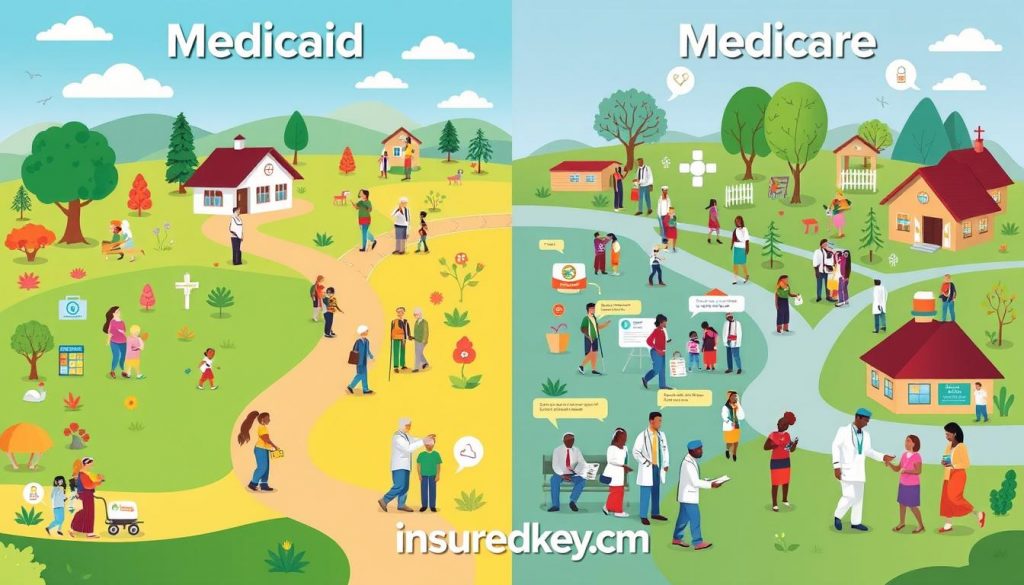Finding the right health insurance is key to getting the medical coverage you need. Most people get health insurance through their jobs. These plans are often cheaper because employers pay a big part of the cost.
This guide will help you understand the different healthcare plans out there. You’ll learn about employer-based plans and individual marketplace plans. Knowing about health insurance can help you make smart choices and find a plan that fits your needs and budget.
Key Takeaways
- Understanding your healthcare needs helps in selecting the right health insurance.
- Employer-based plans are often more cost-effective than marketplace options.
- Familiarize yourself with key insurance terms to better compare healthcare plans.
- Assess out-of-pocket costs vs. premiums to find a balance that suits you.
- Review the services covered by each plan to ensure it meets your specific needs.
- Utilize available resources for assistance in navigating your insurance options.
Understanding Health Insurance Basics
Health insurance acts as a financial shield against medical bills. It helps protect you from high costs. When looking for plans, you’ll come across important terms. Knowing these basics helps you choose the right health insurance for you.
What Is Health Insurance?
Health insurance is a deal between you and an insurer. You pay monthly to get help with medical bills. This includes hospital stays, doctor visits, and more. Plans under the Affordable Care Act offer key health benefits for different needs.
Key Health Insurance Terms to Know
Knowing certain terms makes understanding health insurance easier. Here are some key ones:
- Premiums: The monthly amount you pay for your health insurance plan.
- Deductibles: The amount you must pay out of pocket before your insurance kicks in.
- Copayments: A fixed fee for a specific service, such as a doctor’s visit.
- Network: A group of healthcare providers that have agreed to provide services for lower rates under your health plan.
- Claims: Requests for payment from your insurer for services received.
- Benefits: The health services covered under your insurance policy.
By learning these terms and benefits, you can better understand your options. This helps you get accurate quotes and choose a plan that fits your health needs.
Types of Health Insurance Plans
Knowing about different health insurance plans helps you make better choices for your health. Each plan has its own features, meeting various needs and budgets. We’ll look at the main types, their differences, and benefits.
HMO vs. PPO: What’s the Difference?
Health Maintenance Organizations (HMOs) and Preferred Provider Organizations (PPOs) are two common health insurance plans. HMOs require you to pick a primary care doctor who manages your care. You need a referral to see specialists. This plan is cheaper and suits those who like a set plan for health care.
PPOs offer more freedom. You can see any doctor or specialist without a referral. This flexibility might cost more, but it lets you choose your health care more personally.
EPO and POS Plans Explained
Exclusive Provider Organizations (EPOs) and Point-of-Service (POS) plans add more choices. EPOs don’t cover out-of-network services, so you must use in-network providers. This saves money but limits your choices.
POS plans mix HMO and PPO features. You can choose in-network or out-of-network providers, but out-of-network costs more. POS plans also value primary care, like HMOs.
Short-term vs. Long-term Coverage
It’s important to know the difference between short-term and long-term health insurance. Short-term plans are for temporary needs, like job gaps or waiting for a permanent plan. They’re cheaper but have high costs and limited benefits.
Long-term plans, like HMOs and PPOs, offer full coverage for ongoing health needs. They help manage costs and ensure stable health care over time.
| Plan Type | Network Flexibility | Required Referrals | Average Costs |
|---|---|---|---|
| HMO | Restricted to network | Yes | Lower premiums |
| PPO | In-network & out-of-network | No | Higher premiums |
| EPO | Restricted to network | No | Moderate premiums |
| POS | In-network & out-of-network | Yes | Higher premiums |
Assessing Your Healthcare Needs
Figuring out what healthcare you need is key to picking the right health insurance. Looking at different factors helps you make a smart choice. This means checking your medical history, thinking about prescription costs, and what healthcare services you use often.
Consider Your Medical History
Your medical history tells you about past health problems and ongoing conditions. It shows what healthcare you might need in the future. When looking at health coverage, choose plans that fit your medical needs well.
Prescription Needs and Costs
Prescription costs can really add up. Look at the medicines you take all the time and check the insurance plans’ formularies. Some plans offer more generic meds, which can save you money. Knowing your prescription costs helps you budget for healthcare better.
Regular Healthcare Services
Think about the healthcare services you use a lot. This includes regular check-ups, specialist visits, or emergency care. Making a list of these services helps you pick a plan that covers what you need. This way, you know you’ll get the care you need when you need it.
How Premiums Work
Understanding health insurance premiums is key when choosing your coverage. Premiums are the monthly payments for your policy. Many factors affect these rates, impacting your monthly costs. Knowing these can help you find affordable insurance that meets your needs.
What Influences Your Premium Rate?
Your premium rates can change a lot. Here are some key factors:
- Age: Rates go up with age, especially for those over 60.
- Geographical location: Health care costs vary by area, affecting premiums.
- Coverage level: Plans with lower deductibles have higher premiums.
- Claims experience: Past claims and health care costs can influence rates.
Balancing Premiums and Coverage
Finding the right balance between premiums and coverage is crucial. The American Rescue Plan caps premiums at 8.5% of household income for subsidy-eligible individuals. In 2024, the average Marketplace plan costs about $105/month after subsidies. This makes insurance more affordable for many.
Remember, the total cost of coverage includes out-of-pocket maximums and copayments. When comparing plans, consider these costs.
| Plan Type | Average Monthly Premium (2024) | Average Subsidy per Month | Employee Contribution for Family Coverage |
|---|---|---|---|
| Marketplace (After Subsidy) | $105 | $536 | N/A |
| Employer-Sponsored (Single) | $746 | N/A | $525 |
| Employer-Sponsored (Family) | $2,100 | N/A | $525 |
By considering these factors, you can pick a plan that fits your budget and meets your health needs.
Comparing Health Insurance Providers
Choosing the right insurance provider is a big decision. You need to look at different companies to find the best fit for you. Reading customer reviews helps you understand what others think. Also, checking health insurance ratings can tell you about a provider’s quality and service.
Researching Insurance Companies
Start by learning about different insurance providers. Visit their websites to see what plans they offer and what’s covered. Look for comprehensive healthcare services. The California Department of Insurance (CDI) can help check if companies follow the rules.
Checking Customer Reviews
Customer reviews are key when choosing. Look at both good and bad feedback to get a full picture. Comments on claims, service, and how problems are solved are important. This can help you decide if a provider is reliable.
Accreditation and Ratings
Seeing if a provider is accredited by groups like the National Committee for Quality Assurance (NCQA) is a good sign. Health insurance ratings show how well a company does in service and care quality. Knowing this can help you choose the right insurance for your health needs.
| Provider | Customer Rating | Accreditation | Coverage Options |
|---|---|---|---|
| Blue Shield of California | 4.5/5 | NCQA Accredited | HMO, PPO, EPO |
| Kaiser Permanente | 4.7/5 | NCQA Accredited | HMO, POS |
| Health Net | 4.2/5 | Not Accredited | PPO, EPO, HDHP |
| Anthem Blue Cross | 4.3/5 | NCQA Accredited | PPO, HMO |
The Importance of Coverage Networks
Understanding coverage networks is key when picking healthcare plans. These networks include doctors, hospitals, and urgent care clinics. Providers in these networks charge less, saving you money.
This is especially true for those who see doctors often or need expensive treatments. It can lead to big savings.
In-Network vs. Out-of-Network
Choosing in-network providers saves you money. They have deals with your health plan, so you pay less. Out-of-network providers charge more, which can be a big financial burden.
For example, picking in-network care can save you thousands of dollars over time.
Finding Doctors in Your Network
Make sure your doctors are in your plan’s network. Health insurance companies make it easy to check. You can use online directories, call customer service, or check member portals.
Understanding Deductibles and Copayments
Health insurance can be hard to understand, especially terms like deductibles and copayments. Knowing these helps you plan your healthcare costs. It lets you make smart choices about your health.
What Is a Deductible?
A deductible is what you pay first for most medical services before insurance kicks in. For instance, if your deductible is $2,000, you pay that before getting insurance help. Deductibles vary by plan type and provider network. Some costs, like surgery, help meet your deductible.
Copayment vs. Coinsurance
Copayments are fixed amounts you pay for certain services, like doctor visits. For example, a $20 copay for a doctor’s visit. Coinsurance is a percentage of costs after your deductible is met. Say your plan is 80/20, you pay 20% of costs after your deductible.
These terms show how you and your insurance split healthcare costs. Knowing the difference between copayments and coinsurance helps manage your costs.
| Health Insurance Term | Description | Example |
|---|---|---|
| Deductible | Annual amount paid out-of-pocket before coverage starts. | $2,000 yearly |
| Copayment | Fixed amount paid for specific services at the time of service. | $20 per doctor’s visit |
| Coinsurance | Percentage of costs paid after the deductible is met. | 20% of medical bills under an 80/20 plan |
| Out-of-Pocket Maximum | Maximum annual spending on covered medical costs. | $6,350 total |
State and Federal Health Insurance Programs
It’s key to know about state and federal health insurance programs for the right coverage. Medicaid and Medicare help different groups, and the Affordable Care Act has made healthcare more accessible for many.
Medicaid and Medicare Overview
Medicaid offers low-cost health coverage to low-income families, kids, pregnant women, the elderly, and those with disabilities. Each state has its own Medicaid rules, but they must follow federal guidelines.
Medicare helps those 65 and older, and some younger people with disabilities. It covers hospital stays, doctor visits, and prescription drugs.
Some states have expanded Medicaid to include all adults with low incomes. This has helped many who were uninsured before.
The Affordable Care Act Explained
The Affordable Care Act changed how we get health insurance. It created online marketplaces for easy plan comparison. Many find affordable plans, with four out of five paying $10 or less a month.
In states without Medicaid expansion, those not on Medicare may struggle to find affordable coverage. States like California and Colorado have their own Marketplaces for health coverage.
Enrolling in a Health Insurance Plan
Knowing when to enroll in a health insurance plan is very important. It’s key to understand open enrollment and special enrollment periods. If you miss these times, you might not have insurance when you need it.
Open Enrollment Periods
Open enrollment happens once a year. It’s your chance to pick from many health insurance plans. For those using the ACA Marketplace, this period is from November 1 to January 16.
During this time, you can look at different plans and choose one that suits you. Remember, coverage starts after your first premium payment is made. So, it’s important to watch the deadlines.
Special Enrollment Periods
Special enrollment periods let you sign up for insurance outside the usual times. Events like getting married, having a baby, or losing coverage qualify you. It’s crucial to tell your insurance provider about these changes quickly.
This way, you can avoid gaps in your coverage. Being quick to report these changes helps you keep access to healthcare.
| Enrollment Period | Duration | Eligibility Criteria |
|---|---|---|
| Open Enrollment | November 1 – January 16 | All individuals |
| Special Enrollment | 60 days after qualifying event | Change in life situation (e.g., marriage, birth) |
| Medicaid Enrollment | Ongoing | Income level and state guidelines |
It’s important to stay informed about these enrollment periods. Always check with your insurance provider or the Marketplace for the latest information on your options.
Making Changes to Your Health Insurance
It’s important to keep checking your health coverage regularly. Your life can change a lot, like when you get a new job or have a baby. These changes might mean you need to look at your health insurance again.
Open enrollment is a great time to make any needed changes. You can make sure your insurance fits your current health needs better.
When to Reassess Your Health Coverage
You should check your health coverage at least once a year. Or, anytime a big life event happens. This could be a chance to change your plan during a Special Enrollment Period.
During this time, you have 60 days to pick a new plan. It’s important to act fast because waiting could mean missing out on better deals or coverage.
Changing Plans During Open Enrollment
The Open Enrollment Period is from November 1 to January 15 each year. This is when you can easily change your Marketplace health insurance plan. It’s a good time to think about any health needs or medical costs you might have.
If you cancel your plan outside this time, you might have to wait until next year to sign up again. By staying active in this process, you can protect your health and money.
FAQ
What is health insurance and why do I need it?
Health insurance is a deal between you and an insurance company. It covers your medical costs. This way, you can get the care you need without spending too much money.
What are the essential terms I should know about health insurance?
Important terms include premiums, which are your monthly payments. Deductibles are what you pay before insurance kicks in. Copayments are fixed fees for services. Knowing these helps you make smart choices about your health insurance.
How do I assess my healthcare needs before selecting a plan?
Look at your health history and any ongoing issues. Think about future healthcare needs and medication costs. This helps you pick a plan that fits your health and budget.
What influences my health insurance premium rates?
Several things affect your premium rates. These include your age, coverage level, where you live, and the plans available. Finding a balance between cost and coverage is key.
How do I compare health insurance providers effectively?
Check out different providers by reading reviews and looking at their reputation. Look for accreditation from groups like the National Committee for Quality Assurance (NCQA). This shows they meet high healthcare standards.
What is the difference between in-network and out-of-network providers?
In-network providers have deals with your plan, so costs are lower. Out-of-network providers charge more, so you pay more out-of-pocket.
What is the difference between deductibles and copayments?
Deductibles are what you pay before insurance starts. Copayments are fixed fees for services. Knowing this helps you manage your healthcare costs better.
What are the main state and federal health insurance programs?
Medicaid helps low-income families and individuals. Medicare is for older adults and some disabled people. The Affordable Care Act (ACA) makes insurance more accessible by offering financial help based on income.
What should I know about enrolling in a health insurance plan?
You can sign up for a plan during open enrollment each year. If you have big life changes, like getting married or changing jobs, you might be able to sign up at other times.
When is it necessary to reassess my health insurance coverage?
Review your coverage when big life changes happen, like a job change or moving. Open enrollment periods are also good times to update your plan based on your changing needs.


